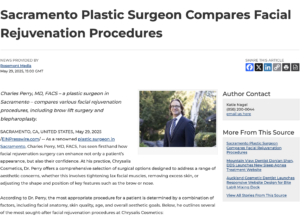Scars can have a number of causes – including surgery, trauma, and even acne. If you are bothered by the appearance of scars on your face or body, our extensively trained Sacramento plastic surgeon offers several treatment options that can address this concern. During your initial consultation, you and Dr. Charles Perry can discuss your needs and goals and develop a customized plan to reduce the severity of your scars.
- What Is Scar Reduction?
- Types of Scars
- Scar Reduction Treatment Options
- Scar Reduction Recovery
- Scar Reduction Cost
What Is Scar Reduction?
Scar reduction, also called scar revision or scar correction, is a catch-all term for treatments designed to soften the appearance of scars and make them less visible. The right approach for you will depend on the type of scar, its location, and your personal preferences. Dr. Perry can evaluate your scars and determine which, if any, method is ideal for your unique needs and desired outcome.
What Types of Scars Can Be Treated?
Many of our patients are most concerned with minimizing the appearance of surgical scars that result from a cosmetic or medical procedure, such as a facelift, ear piercings or gauges, a breast lift, or tummy tuck surgery. Other individuals, however, may be bothered by the lasting appearance of acne scars or an injury that occurred earlier in life.
Some of the most common types of scars are:
- Keloid scars: This is a very visible scar that results from an aggressive healing response by the body. Keloid scars typically extend beyond the boundaries of the original wound and may become stiff and even restrict movement in the area. They can be raised, red or otherwise pigmented, and bothersome. Individuals with darker skin are often at higher risk of developing keloid scars.
- Contracture scars: Scars that tighten significantly over time are known as contracture scars. These can become restricting and even affect muscles, nerves, and deeper tissues. Contracture scars typically result from burns.
- Hypertrophic scars: Easily confused with keloid scars, hypertrophic scars can also be raised and pigmented, but they will not go beyond the original edges of the wound.
- Acne scars: These frustrating after-marks of blemishes are typically small and may be pigmented or not. They can also be indented or textured. As different acne scars require different types of treatment, it is important to evaluate the concern when determining how to address the issue.
- Surgical or traumatic scars: Surgery and traumatic scars can range in size and appearance. If your surgery was performed by Dr. Perry, he will make every effort to ensure the outcome is as inconspicuous as possible. That said, surgical scars that do appear can often be addressed with advanced aesthetic treatments.
Which Scar Reduction Procedures Are Available?
Choosing the right scar reduction treatment begins with identifying the type of scar you would like to address. Depending on the nature of your concerns, Dr. Perry may recommend one (or a combination) of the following options.
- Laser skin rejuvenation. Advanced laser technology (such as the HALO™ Hybrid Fractional laser system) can target scars and other blemishes, encouraging the growth of new, healthy skin cells.
- Topicals (e.g. lotions and creams). At Chrysalis Cosmetics, we proudly carry some of the most popular physician-grade skin care products on the market. A member of our team can help you select a product to ease your scars.
- Injections (Kenalog®, fluorouracil, and others). At Chrysalis Cosmetics, we often utilize pharmaceuticals to enhance the natural healing process of the body to optimize the appearance of the healing incisions. Fillers such as JUVÉDERM® may also be used to relieve the depressions.
- Surgery. For more severe scarring that does not respond to less invasive treatments, surgery may be the ideal solution. Surgical scar removal generally involves the removal of scar tissue and re-suturing of the skin to create a smoother, more aesthetically pleasing appearance. In certain cases, a skin graft may be used to improve the outcome.*
What Is Recovery Like After Scar Reduction?
Recovery after scar reduction varies depending on the type of procedure performed. Less invasive options (such as laser therapy) often have a shorter recovery period, while surgical scar revision typically requires a longer healing process. Alternatively, topicals are applied over a period of weeks or months to help flatten and fade the scar.
No matter the unique nature of your needs and the procedure administered, it is essential to keep the treated area clean and follow any specific care instructions provided by Dr. Perry. He and our team will discuss your aftercare plan in greater detail during your consultation.
How Much Does Scar Reduction Cost?
The cost of your scar reduction procedure is contingent upon the type of treatment you receive, the size and location of the scar(s), the complexity of the procedure, and other variables. During your consultation, Dr. Perry will assess your scars and provide a detailed estimate based on your personalized treatment plan.
At Chrysalis Cosmetics, we strive to make scar reduction accessible by offering a variety of plastic surgery financing options to eligible patients. For more information on financing, our team can guide you through the application process and discuss available plans.
If you wish to address scars of any kind, Dr. Perry would be glad to meet with you. Reach out to Chrysalis Cosmetics today to learn more about our scar treatments and revision techniques.


